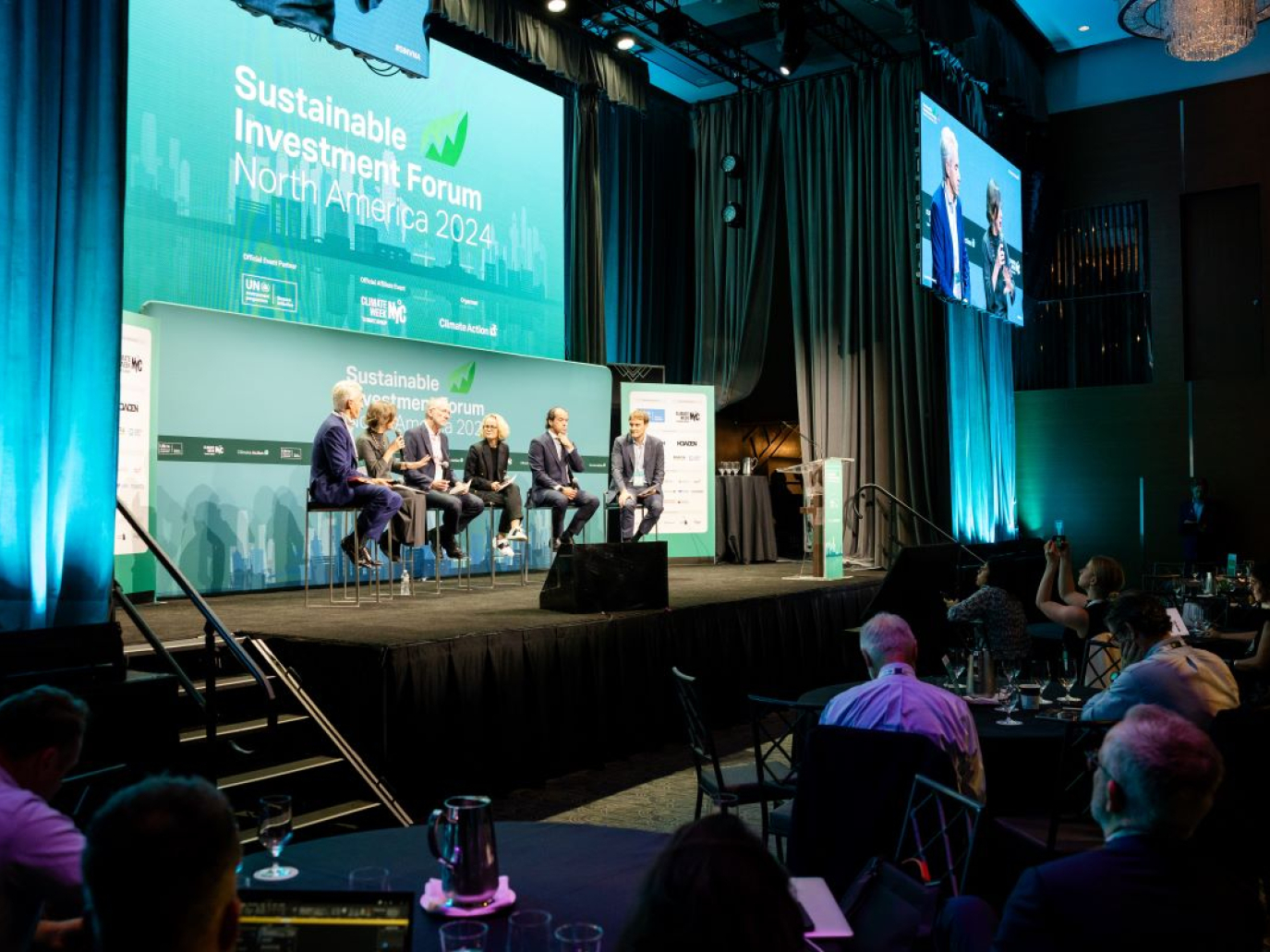This article is also available in Italian / Questo articolo è disponibile anche in italiano
From New York - On 24 September 2024, the Ziegfeld Ballroom, Manhattan's mecca for gala events, became the stage for the 9th annual North American Sustainable Investment Forum. The Forum, organised by Climate Action in collaboration with the UN Environment Programme Finance Initiative, brought together over 620 institutional investors and financial companies, totalling $3 trillion in assets under management.
While the average atmospheric temperature continues to exceed the 1.5° C set by the Paris Agreement and the COP29 in Baku, hosted in the backyard of the oil industry, is just around the corner, the financial community is indeed called upon to act quickly. Between greenwashing (and a touch of bitter sarcasm comes easy here, given that films such as Apocalypse Now, Cabaret and Close Encounters of the Third Kind debuted at the Ziegfeld) and real commitments to decarbonising portfolios, however, this urgency is being compounded by regulatory uncertainty and macroeconomic estimates. Not to mention the geographical and political polarisation, including around the US presidential election, which will have the most immediate impact in North America.
However, at the Forum the real question seems to be another one. Is the ‘CAPEX mentality’, i.e. the approach based on capital costs and short-term performance paroxysm, going to change or not? Regardless of the answer, as in Apocalypse Now, the imperturbable air at the Ziegfield has the feel of a journey to a warmer world (how much we do not yet know) in which it will be the journey, more than the final destination, that will bring the greatest satisfaction.
The risk of a ‘dangerous two-speed global transition’
“Decarbonization is inevitable and is the biggest transformation of the global economy of this century. Which makes climate action a very, very smart thing. But on the other hand, what you’re doing is not easy. It’s not easy at all.” It was with these words that Simon Stiell, Executive Secretary of the United Nations Convention on Climate Change (UNFCCC), opened his speech at the Sustainable Investment Forum in North America.
Despite high interest rates, often inconsistent public policies and supply problems, the secretary estimated that financial flows for climate action already exceed $1 trillion. By 2024, investments in solar photovoltaics alone will grow to over USD 500 billion. This is more than the total amount invested in all other power generation technologies combined.
“Transformation is needed in every sector, and that spells opportunity in every sector. But - and it’s a big but - right now, the vast majority of this money is flowing to projects in the biggest economies. This clean energy mega-trend is progressing unevenly”, Stiell added. If more developing countries do not see this increasing flow of investment, the UNFCCC chief warned, a ‘dangerous two-speed global transition’ will quickly set in. Stiell himself, in February, had indicated a figure of at least USD 2.4 trillion to maintain global climate change targets.
Closing the financing gap in developing countries
So what is missing to close this gap? “What we need is a more integrated approach that brings together different stakeholders within the climate finance ecosystem. This means leveraging blended finance − essentially combining different types of funding sources − to attract concessional capital providers. These could be DFIs (Development Finance Institutions), MDBs (Multilateral Development Banks), and foundations, all of which can play a catalytic role in mobilizing private capital on a large scale”, explained to Renewable Matter Joe Leavenworth Bakali, Senior Programme Associate and Catalytic Climate Finance Facility Lead of the Climate Policy Initiative, an international analysis and consulting organisation based in San Francisco, California.
“While there are many strong teams out there looking to scale innovative climate finance solutions, particularly in developing economies, they often lack access to resources”, Bakali adds. “Right now, fundraising timelines are extremely long, and traditional investors see embedded risks when it comes to investing in developing economies. These risks include a perceived misalignment between risk and return, as well as a lack of awareness or education around specific climate sectors.”
“Capacity building is a key part of that. But it's also about layering in financial de-risking mechanisms, such as guarantees and insurance products, alongside capacity building for institutions”, Bakali concludes. “This combination is critical to enabling more capital to flow into areas like sustainable agriculture and the blue economy. These sectors have historically been underserved and undercapitalized, but they are crucial to adaptation and mitigation efforts in developing economies.”
The role of policies and a push from the Inflation Reduction Act
As Draghi‘s own report on European competitiveness points out, with the Inflation Reduction Act (IRA) the US has stepped on the gas. The IRA, the most important climate law ever passed by Washington, aims to reduce US emissions by 40 per cent by 2030, ‘while supporting disadvantaged communities and the clean energy industrial base’. Adding to this are the resources released by the bipartisan Infrastructure Bill (BIL) and the CHIPS and Science Act. The former contains (among other things) plans for climate resilience, while the latter supports federal production of semiconductors.
One of the most significant areas illustrating the link between finance, climate and global trade is green hydrogen. However, there is a high risk of confusion when it comes to funding, especially with blue hydrogen, which is produced from methane, as the $900 million allocated to the Appalachian Hydrogen Hub (ARCH2) shows. In fact, (green) hydrogen represents a great opportunity, especially for countries that are able to produce it on a large scale. “If you think of green molecules as a vector for decarbonization, it's essentially a way to deliver green electricity globally”, Nabil Bennouna, Principal al Rocky Mountain Institute (RMI) for the Climate Aligned Industries, explains to Renewable Matter. “This means you're no longer limited by the constraints of transmission markets. By turning energy into a liquid or fuel, you can provide decarbonization as a service, moving it from point A to point B anywhere in the world.”
“Certainty for investors is important, too. One of the key points I often use is that in this transition phase, in many cases, the policy is the product, Bennouna adds. “Take green hydrogen, for example, with the 45V tax credit (a U.S. incentive for clean hydrogen production). More than half of the revenue potential comes from a regulatory support mechanism. So, you're essentially creating value through policy, not just through the energy content alone. It's about the energy combined with the ability to achieve that policy goal with high integrity. This serves as a bridge to ultimately recognizing the full value of the climate attribute itself.”
Sustainability reporting, efficiency also in data
In addition to the harmonisation of ESG standards, the annual Sustainable Investment Forum in North America also issued a strong call for optimisation. “We must do more, with less”, Sherry Madera, Chief Executive Officer CDP, says to Renewable Matters. “For too many companies, they worry there is too much data asked of them at too high a cost. Reporting is one of the most powerful tools we have. We need to ensure that the most meaningful data points are disclosed just once, but used for any purpose – less duplicative disclosure, less time and less expense. Putting data to use for the highest impact and creating new products, sustainability linked loans – like the likes of Citibank, Walmart, HSBC and BBVA are doing with CDP data.”
CDP, formerly the Carbon Disclosure Project, is a non-profit organisation that runs a global disclosure system to help investors, companies and governments manage their environmental impact. Data collected on greenhouse gases, water use, deforestation and the supply chain is used by institutional investors and policy makers to develop sustainability and responsible investment strategies. ‘Standardisation is key', Madera concludes. “CDP is supporting convergence around the ISSB and TNFD standards as their key disclosure partner and providing capital market requestors – 700 of them with $142 trillion in assets – with a core, dense, globally comparable environmental dataset. This convergence makes the reporting process more valuable and means it can be deployed for many uses more easily.”
Images: Sustainable Investment Forum



